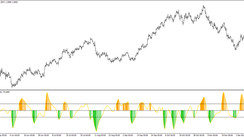Yesterday's Bank of Canada meeting, which ended with a 0.50% interest rate hike to 1.0%, was positive for the CAD, which, by the way, is part of a basket of 6 major currencies in the DXY dollar index with part of around 9.1% (the euro accounts for 57.6%).
"Surges in the prices of oil, natural gas and other commodities are driving inflation around the world. Supply disruptions ... are also further exacerbating current problems and reducing business activity. These factors are key in the context of the upward revision of the Central Bank's inflation forecast", said in the Bank of Canada.
The bank now expects inflation to average 5.3% this year, rather than the 4.2% previously forecast. Inflation will be around 6% in the first half of the year and remain "well above" the 2% target in the second half. "In view of excess demand emerging in the economy and inflation remaining well above the target, the Governing Council decided that it is necessary to continue raising interest rates", the Bank of Canada said, adding that the timing and pace of further interest rate hikes will depend on incoming economic data.
Inflation in the country accelerated to a thirty-year high (in February 2022, consumer prices in Canada rose at an annualized rate of 5.7% after rising by 5.1% in January. This is the highest rate since August 1991).
The Bank of Canada estimates that the neutral level of the interest rate, at which it does not stimulate or slow down economic activity, is 2.25%. Most economists expect the key interest rate to reach 2% by the end of 2022 (compared to expectations of 1.75%-2.0% of the Fed rate by the end of the year, with a 0.25% increase at each meeting).
Thus, the monetary policy parameters of the Bank of Canada run almost in parallel with the monetary policy parameters of the Fed. At the same time, inflation in Canada is still less than in the US, and rising oil prices provide strong support to the quotes of the Canadian currency.
At the same time, the Fed faces a difficult task: with inflation running rampant, to tighten monetary policy in such a way as not to harm economic growth.
Conclusion: the Canadian dollar is a serious competitor to the US dollar, which is likely to be taken into account by long-term investors.
Since January 2021, the USD/CAD pair has been trading in a range between the levels of 1.2960 and 1.2010. At the same time, the 200-period moving average on the monthly USD/CAD chart, passing through 1.2540, acts as a kind of balance line or median line. Its breakdown will send USD/CAD towards the lower border of the range and towards 1.2010, for a start. This, in turn, will mark the final break into the long-term bear market zone (also see Technical Analysis and Trading Recommendations).
Of the news for today, apart from the ECB meeting, which may also increase volatility in the market, one should pay attention to the publication at 12:30 (GMT) of weekly data from the US labor market and data on retail trade in the US for March. And at 14:00 USD, the University of Michigan consumer confidence index (preliminary release) will be published, which reflects the confidence of American consumers in the economic development of the country. A high level indicates growth in the economy, while a low level indicates stagnation. Previous indicator values: 59.4 in March, 62.8 in February, 67.2 in January 2022. Forecast for March: 59.0. The data is worse than the previous values and the forecast may have a negative impact on the US dollar in the short term.
And tomorrow the Catholic world will celebrate Good Friday. Banks and exchanges in these countries will be closed.





